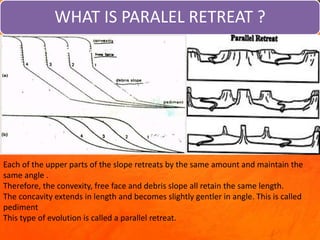Model on landform evolution: Penck// geomorphology unit 1
It may be pointed out that German scientist Walther Penck pleaded for the rejection of Davisian model of geographical cycle based on time-dependent series of landform development and presented his own model of ‘morphological system’ or ‘morphological analysis’ for the explanation of landscape development.
• Contrary to the concept of W.M. Davis, ‘that landscape is a function of structure, process and time (stage)’, Walther Penck postulated that, ‘geomorphic forms are an expression of the phase and rate of uplift in relation to the rate of degradation.
• It is assumed that interaction between the two factors, uplift and degradation, is continuous.
Penck’s views could not be known in true sense and
could not be interpreted in right perspective because
of:
• (i) His incomplete work due to his untimely death,
• (ii) His obscure composition in difficult German language,
• (iii) Ill-defined terminology,
Basic concept of landform development:
• Landform development is time-independent.
• The landforms, reflect the ratio between the intensity of
endogenetic processes (i.e., rate of upliftment) and the
magnitude of displacement of materials by exogenetic
processes (the rate of erosion and removal of matrials).
• Rate of erosion is proportionally related to slope.
• Upliftment and erosion are always co-existent.
• The land slope has a parallel retreat; so same slope angle over time.
Primarumpf:
• Primarumpf is primary peneplain that represents either newly emerged surface from below sea level or a ‘fastenbene’ or ‘peneplain’• primarumpf is the initial landscape with evidences of erosion but with low altitude.
• According to O.D. Von Engeln (1960) “Penck found escape from the concept of cyclic change marked by the stages youth, maturity and old age.” In the place of ‘stage’ he used the term entwickelung meaning thereby development.
• Thus, in the place of youth, maturity and old stages he used the terms aufsteigende entwickelung (waxing or accelerated rate of development), gleichformige entwickelung (uniform rate of development) and absteigende entwickelung (wanning or decelerating rate of development).

Aufsteigende Entwickelung:
• Aufsteigende entwickelung means the phase of waxing (accelerating) rate of landform development. Initially, the land surface rises slowly but after some time the rate of upliftment is accelerated.• Because of upliftment and consequent increase in channel gradient, flow velocity and kinetic energy and of course increase in discharge (not due to uplift) the rivers continue to degrade their valleys with accelerated rate of down-cutting (valley deepening or incision) but the rate of upliftment far exceeds the rate of valley deepening (say degradation of uplifted landmass).
• Continuous active downcutting and valley deepening results in the formation of deep and narrow V shaped valleys. As the rate of uplift (aufsteigende entwickelung) continues to increase the V shaped valleys are further deepened and sharpened. Since valley deepening does not keep pace with the upliftment of landmass the absolute height continues to increase.
• The valley side slopes are continuously steepened due to continued valley deepening. The radius of convexity of slopes is reduced with passage of time due to parallel retreat of the steeper slope segments. With the passage of time and more accelerated uplift and degradation the primary peneplain or say primarumpf is surrounded by a series of benches called as piedmont treppen.

Gleichformige Entwickelung:
• Gleichformige entwickelung means uniform development of landforms. This phase may be divided into 3 subphases on the basis of rate of uplift and degradation.• Phase (a): • Is characterized by still accelerated rate of uplift. Absolute height still increases because the rate of erosion is still less than the rate of upliftment.
• Phase (b): • Altitude (absolute relief) neither increases nor decreases i.e. remains constant due to matching of upliftment by the lowering of divide summit due to denudation. It means that upliftment still continues.
• Phase (c): • Upliftment of the land stops completely. Absolute reliefs or altitudes of summit divides start decreasing because of absence of upliftment but continued erosion of summits of divides.
• Absteigende Entwickelung:
• Absteigende entwickelung means wanning development of landscape during which the landscape is progressively dominated by the erosional process of lateral erosion and consequent valley widening and marked decrease in the rate of valley deepening through vertical downcutting.• This phase is marked by progressive decline of landforms. Absolute relief (altitude from sea level) decreases remarkably because of total absence of upliftment but continued downwasting of divide summits. Relative relief also decreases because the divide summits are continuously eroded down and lowered in height while downcutting of valley floor decreases remarkably due to decrease in channel gradient and kinetic energy.
• Now the valley side slope consists of two segments. The uppermost segment maintains its steep angle inspite of continuous lowering of ridge crests. This slope is called gravity slope or boschungen. The lower segment of the valley sides is called wash slope or haldenhang. Haldenhang, composed of talus materials of lower inclination, is formed at the base of the valley sides due to rapid parallel retreat of gravity slope or boschungen and consequent elimination of much of the convex waxing slopes.
• Thus, the intersection of boschungen and haldenhang produces sharp knick (break in slope).
Eventually, inselbergs are also consumed and the whole landscape is dominated by a series of concave wash slopes or haldenhang. Such extensive surface produced at the end of absteigende entwickelung is called ‘endrumpf’, which may be considered equivalent to Davis’ peneplain.












0 Comments